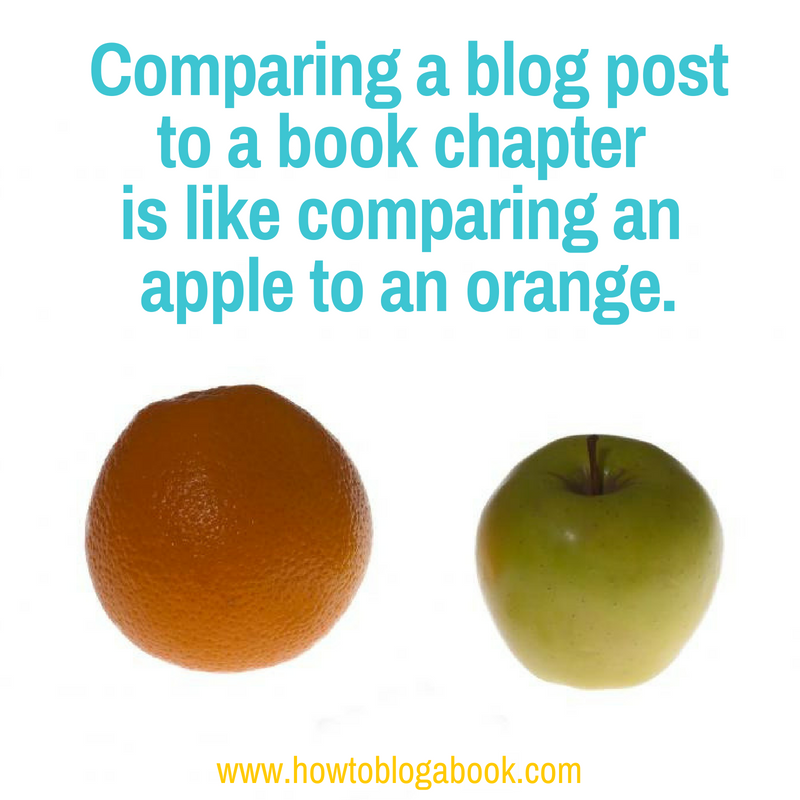If you plan to blog a book, one thing is for sure: a post is different than a chapter. What are the differences? That’s what writer and journalist Jane Meggitt (@meggitt_jane) discusses in this information-packed post. Read on to discover the difference between the two.
Even if you have lots of blogging experience under your belt, writing a book is a whole different animal. And if you feel confident about writing a book, crafting a blog post might feel difficult and scary.
Specifically, it’s crucial to recognize differences exist between writing a blog post versus a book chapter. Those differences hold true even if you blog your book since the blog-post-sized bits of your chapters have to read like posts.
Remember: Each blog post is just one small section of a chapter. A chapter contains many ideas related to one topic; it gets the point across while sharing a variety of related ideas. A blog post tends to elaborate on just one idea or topic at a time.
Let’s look at the nine elements that differentiate a blog post from a book chapter.
1. Timeliness
Timeliness is the essence of blog posts. That’s why the most recent posts are always at the top, so they are seen and read first. That means the reader doesn’t begin on page #1 of your book or necessarily at the beginning of a chapter. That fact holds true whether you write stand-alone posts or blog a book.
2. Content
In a chapter, the reader expects to discover content related to the topic of that chapter—and nothing else. A chapter doesn’t have “interruptions,” like a section on related news events, which would be outdated by the time the book was published.
That’s not true for a blog post. You can publish posts relating to your book, such as information about researching your material, that won’t appear in the actual book—only on the blog. That means you can write a post on a news event, a course you are offering, or some experience you had and publish it mid-chapter. Readers will then pick up on the story with the next post.
3. Reading Time
Blog posts present information in an easy-to-read format and don’t require the reader to look much beyond the post if they want specific answers to specific questions. They are short and succinct, which means they don’t take long to read.
On the other hand, book chapters take up more of the reader’s time, draw them in, and make them want to continue reading until the end. In fact, they have to read to the end to receive all the information related to the chapter’s topic.
When you blog a book, each post must pique the reader’s interest in what is coming next, so they can’t wait to read the next installment. In a book, you must do the same but get readers to continue reading from chapter to chapter.
4. Length
Then there’s length to consider. The reader expects a different length—and reading time—from blog posts and chapters.
Even if your blog posts trend toward the longer end of the genre, they won’t be as lengthy as typical book chapters. A blog post ranges between 600 and 1,500 words; some run as long as 2,500 words but posts that long would not be recommended when blogging a book.
Post length is always affected by both the topic and the reader’s attention span. If blogging a nonfiction book, keep the post between 350 and 750 words. Ideally, it should never take a reader longer than seven minutes to consume a blog post.
That’s not the case with book chapters, which generally demand a 3,000 to 4,000-word minimum. Although exceptions exist (such as in some ebooks), a lengthy blog post or a short book chapter likely will fall short of meeting reader expectations. And readers have expectations, even if they aren’t cognizant of them. They recognize intuitively that chapters should fall within a certain length, although that varies by the type of book and subject matter.
There’s always the vital issue of the author’s voice, and you must stay true to that, whether your chapters or posts tend toward short or long or you’ve planned them just right.
5. Scanability
A nonfiction book chapter likely will feature a few breaks indicated by subheadings. It also may have sections that feature bulleted or numbered items.
Blog posts also sport subheadings, typically one every 300 words or less. Today, many readers want to scan a post and primarily read the headings and bullet points. That means a post requires many subheadings and content more frequently broken out into lists of one sort or another.
6. Memoirs and Novels
When writing a memoir or novel, each chapter often consists of several scenes and has its own story arc within the larger story arc. If you are blogging a memoir or novel, the blog posts would consist of just one scene, a bit of description, or dialogue; a post would not include an entire chapter unless you were serializing your book.
7. SEO
Book chapters have existed for hundreds of years – thousands if you count the “chapter and verse” of religious texts. Blog posts came into existence in the late 20th century, roughly the same time as Search Engine Optimization (SEO).
When writing for the internet, you must keep SEO in mind. That means you should include your keyword throughout the post. Specifically, craft your first paragraph so it includes the keyword and includes it in at least one subheading as well.
For a book chapter, SEO may or may not prove necessary. These days everything is searchable online—even a book.
Also, blog post needs images tagged with the keyword to help discoverability and spark reader interest. That’s not necessary with a book chapter.
8. Social Media Shares
When writing a blog post or blogging a book, you’re thinking about how to get the content read and shared. That’s not the case when writing a book.
You may want to post somewhat edited chapters of your book; Nina Amir did this with her book, The Author Training Manual. But don’t exceed 1,250 words; that’s the ideal word-count limit for social media sharing. Research seems to prove that longer posts receive more traffic and social shares. But you’ll gain more traction in Google with shorter and more frequent blog posts.
Again, subject matter and audience define post length to a great extent. You want to leave your audience wanting more and eager for the next chapter if you post chapters, which again is not blogging a book but serialization. Think of a chapter designed for social media sharing as a sort of teaser, so readers can’t wait to find out what happens – especially if you want them to purchase the published book.
9. Online Versus Offline
When it comes to differences between blog posts and book chapters, here’s the bottom line: the former is designed for online consumption, while the latter is not. Write blog posts with online readers in mind; remember that SEO is essential to attracting readers, and blog visitors want to complete their visits fast while still gaining value. Write chapter with book readers in mind; they may find your book online—and even purchase it online—but they expect to sit and enjoy a book for many hours if not days.
Can you think of any other differences between blog posts and chapters? Tell me in a comment below.
About the Author
 Jane Meggitt is a former reporter for a major New Jersey newspaper chain. Her work has appeared in dozens of publications, including USA Today, Financial Advisor, LegalZoom, Zack’s and The Motley Fool.You can contact her at janemeggitt@gmail.com.
Jane Meggitt is a former reporter for a major New Jersey newspaper chain. Her work has appeared in dozens of publications, including USA Today, Financial Advisor, LegalZoom, Zack’s and The Motley Fool.You can contact her at janemeggitt@gmail.com.
Photo courtesy of GeoffreyWhiteway


Thanks for sharing your article. Another difference that comes to mind is:
Blog posts are intended to promote interest in the book, not the reverse
As I am blogger, but don’t have any book writing experience, but I want to write book someday. I just want to ask author can you share tips on how to market research for first book?
There is some info on this site as well as on writenonfictionnow.com. Or join the Nonfiction Writers’ University for group author coaching with me. Then I can help you more. https://ninaamir.com/nfwutrial/